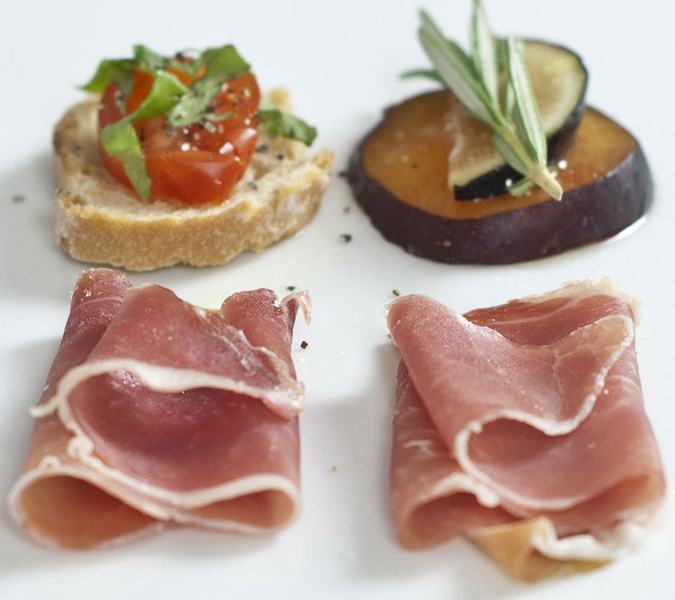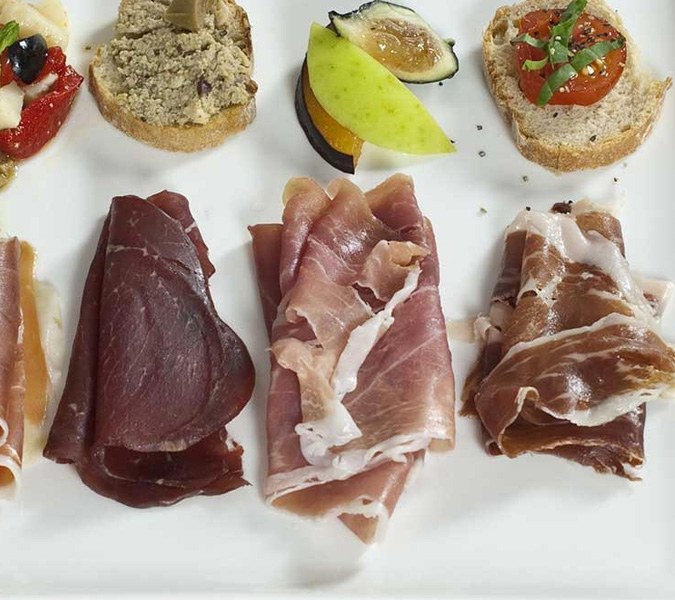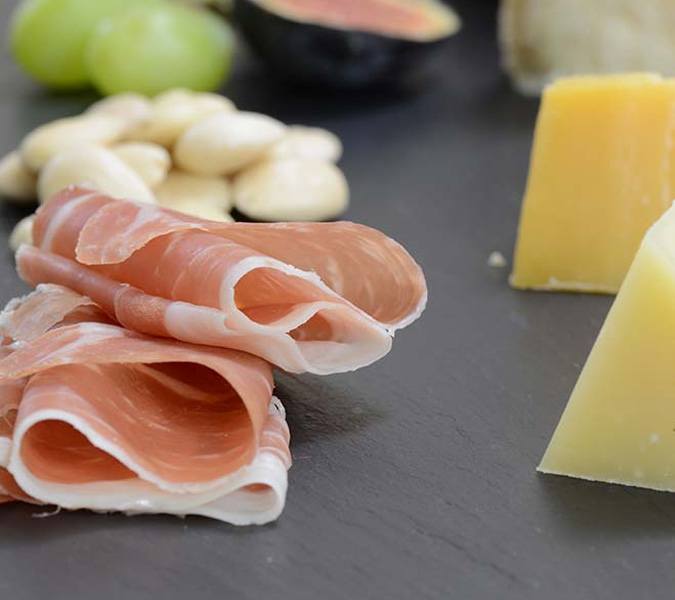Made in Italy since the ancient Roman times, prosciutto is an Italian delicacy made from a pig’s hind leg meat. ‘Prosciutto cotto’ refers to cooked ham, whereas ‘Prosciutto crudo’ is raw and cured. In the USA, we tend to associate the term with the cured “crudo” variety. You can purchase it in pre-sliced wafer-thin pieces, or as a whole leg to use as a centerpiece to a lavish family meal.

Practically every region in Italy has its own version, each slightly different to the next, but the most prestigious varieties tend to come from northern and central Italy. The taste and texture of each depends largely on the breed of pig, its diet, altitude, processing techniques, and other factors.
How is Prosciutto Made?
When it comes to making crudo, the leg is usually cleaned and salted before being left in a cool place for several weeks or months. During this time, the salt adds flavor but also acts as a preservative, removing moisture from the meat and preventing harmful bacteria from surviving. Later, the salt is largely removed from the meat, which is then dried for up to 18 months. This entire curing process can sometimes take 2 whole years.
The History of Italian Prosciutto
Prosciutto's origins can be traced to ancient Rome, where people discovered that salting and drying meat was a way to preserve it. The word "prosciutto" itself comes from the Latin "perexsuctum," which means "thoroughly dried".
In ancient times, the process was a necessity rather than a culinary art. Farmers would salt and dry the pork legs to keep them edible for longer periods, especially during the winter months when fresh meat was scarce. Over time, this method evolved into a more refined technique, with regional variations developing across Italy.
The region of Parma, in northern Italy, became particularly famous for its prosciutto. The unique climate, with its cold winters and warm summers, provided the perfect conditions for curing the meat. By the Middle Ages, prosciutto di Parma had gained a reputation for its exceptional quality, and it was often served at the tables of nobility.
In addition to Parma, the town of San Daniele in the Friuli Venezia Giulia region also became known for its own version. Each region's ham has its own distinct flavor, influenced by factors like the breed of pig, the diet, and the curing process.
How to Eat Prosciutto?
Like most hams, this can be enjoyed by itself but is usually eaten as an accompaniment, topping or wrapping for other foods. Italians will often wrap it around a chunk of cheese, or skewer it alongside olives and fresh fruit. It also tastes great on pizza or in salads and sandwiches.
Types of Prosciutto
Prosciutto di Parma
The most famous and celebrated prosciutto is Prosciutto di Parma, so revered it has its own Designation of Origin protected by European Law. Beloved for its exquisite sweet-and-salty flavor, this is salted and dried for at least 18 months, and must be made in the hills around Parma using only Duroc, Large White or Landrace breeds of pig. In spite of its highly selective and closely monitored production methods, it can vary widely in flavor, sometimes adding nutty or buttery overtones to the usual sweet-salty combo.

Prosciutto di San Danielle
This is made around the village of San Danielle Del Friuli. It is darker in color and sweeter in taste than Di Parma, making it better suited to cheeses and breads than to larger savory dishes.
Speck Alto Adige PGI
Produced in northern Italy’s South Tyrol region, Speck is often crafted according to the adage: “A little salt, a little smoke, and a lot of fresh air.” Made from firm pork thighs, it often includes seasonings like pepper and rosemary. Locals in Tyrol often eat it in small cuts alongside sausages, pickles and local cheeses, not to mention bread and wine.
Prosciutto di Modena
The province of Modena is famous for its balsamic vinegar, but it also produces a time-honored cured ham with bright meat. Less salty and more aromatic than di Parma, it is best enjoyed with fruits such as melon or fig.
Prosciutto Toscano
Cured in Tuscan spices like pepper, garlic and juniper, as well as in salt, this has an earthy, herbaceous flavor profile. In Tuscany, locals often enjoy it with unsalted bread, and its potent seasonings make it an excellent enhancement for mild-tasting dishes.
How Do I Serve Prosciutto?

Serving this delicacy is simple and delicious. It’s best enjoyed at room temperature, allowing its flavors to fully develop. Lay thin slices on a platter, and pair them with melon, figs, or fresh bread for a classic Italian appetizer. It also shines in salads, adding a savory contrast to fresh greens. For a more indulgent option, wrap it around asparagus or cheese and bake until crispy. It’s perfect on a charcuterie board with olives, nuts, and other cured meats. The key is to keep it simple, letting the delicate flavor and texture take center stage.
How to Store Prosciutto at Home?
Storing properly ensures it stays fresh and flavorful. If you’ve bought it pre-sliced, keep it in the fridge, wrapped in wax paper or parchment, and then sealed in an airtight container. This helps retain its moisture while preventing it from absorbing other odors. Whole legs should be hung in a cool, dry place, or kept in the fridge if it’s been sliced into. Make sure to wrap the exposed cut end tightly with plastic wrap to avoid drying out. Always bring prosciutto to room temperature before serving for the best taste.
Calories and Benefits of Prosciutto
This ham is surprisingly low in calories. A one-ounce serving has around 70 calories, making it a lighter option compared to other cured meats. It’s also rich in protein, which is essential for muscle repair and growth. While prosciutto is high in sodium, it’s also a good source of vitamins and minerals like iron, zinc, and B vitamins. These nutrients are healthy and great for supporting overall health, particularly the immune system.
How Long Does Prosciutto Last?
Prosciutto is inherently a food with a long shelf life - after all, it was invented precisely to preserve meat. Usually presented in vacuum-sealed packages that can last several weeks in the fridge, once opened, it is best to consume sliced prosciutto within 3-5 days for optimal freshness. Whole legs of prosciutto can last much longer, even several months, if stored properly in a cool, dry place.
Conclusion
This is one of the most delicious and versatile foods we carry - we turn to it to prepare an amazing charcuterie board for entertaining, to create a filling yet delicious sandwich for a workday lunch, or even for a fresh appetizer of fresh melon and prosciutto in the summer. With so many ways to enjoy it, it’s no surprise it’s also one of our best-selling products at Gourmet Food Store!